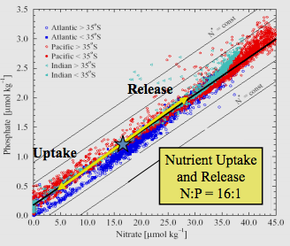
Back Redfieldforholdet Danish Redfield-Verhältnis German Relación de Redfield Spanish Rapport de Redfield French レッドフィールド比 Japanese Redfieldforholdet NB Relação de Redfield Portuguese Пропорція Редфілда Ukrainian

The Redfield ratio or Redfield stoichiometry is the consistent atomic ratio of carbon, nitrogen and phosphorus found in marine phytoplankton and throughout the deep oceans.
The term is named for American oceanographer Alfred C. Redfield who in 1934 first described the relatively consistent ratio of nutrients in marine biomass samples collected across several voyages on board the research vessel Atlantis, and empirically found the ratio to be C:N:P = 106:16:1.[1] While deviations from the canonical 106:16:1 ratio have been found depending on phytoplankton species and the study area, the Redfield ratio has remained an important reference to oceanographers studying nutrient limitation. A 2014 paper summarizing a large data set of nutrient measurements across all major ocean regions spanning from 1970 to 2010 reported the global median C:N:P to be 163:22:1.[2]
- ^ Redfield, AC (1934). "On the proportions of organic derivatives in sea water and their relation to the composition of plankton" (PDF). James Johnstone Memorial Volume: 176. Retrieved March 1, 2019.
- ^ Martiny, Adam C.; Vrugt, Jasper A.; Lomas, Michael W. (9 December 2014). "Concentrations and ratios of particulate organic carbon, nitrogen, and phosphorus in the global ocean". Scientific Data. 1 (1): 140048. doi:10.1038/sdata.2014.48. PMC 4421931. PMID 25977799.
© MMXXIII Rich X Search. We shall prevail. All rights reserved. Rich X Search